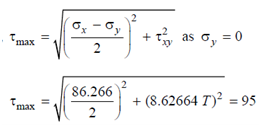Magnitude of torque - bending moment:
A prismatic bar of hollow circular cross-section along with outer and inner diameters 100 mm and 80 mm correspondingly, carries a bending moment of 5 kN-m. If the tensile, compressive and shear strengths of the material are given as 140 N/mm2, 125 N/mm2 and 95 N/mm2 respectively, what is the magnitude of torque that may safely be applied in addition to the bending moment.
Solution
Here, the criteria to be considered are as follows:
σ1 › 140 N/mm2
σ2 ›- 125 N/mm2
τmax › 95 N/mm2
As the magnitudes of σ1 and σ2 for such bars will be equal, we need to satisfy only.
σ2 ›- 125 N/mm2
and
τmax › 95 N/mm2
I for the section π/64(1004 -804) = 2.898 × 106 mm4
J for the section π/32(1004 -804) = 5.796 × 106 mm4
Maximum compression due to bending moment,
= - M/I ymax = -5×106× 50/2.898× 106 = - 86.266 N/mm2
If T be the torque applied (in kN-m units), then,
τmax = T×106×60/5.796×106 = 8.62664 T N/mm2 (under torsion alone)

43.1332 + 8.626642 T 2 = (- 81.867)2
i.e. T = (81.8672 - 43.1332/ 8.626642)1/2 =8.066 kN-m
If the applied torque is within 8.066 kN-m, we are certain that the bar will be safe in compression as well as tension.
We should now analyse what torque will have to be applied if τmax › 95 N/mm2.
We know that

(under combined bending and torsion)
T= (952 -(86.266/2)2/8.626642)1/2 = 9.8119 kN-m
Thus, we cannot apply this much torque, because it will cause compression failure. Therefore, the safe value of additional torque should be restricted to 8.066 kN-m.